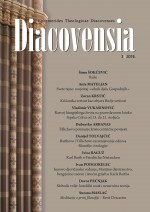SLAVENSKI LITURGIJSKI IZVORI OD IX. DO XIII. STOLJEĆA
THE DIVERSITY OF CONTENT OF SLAVIC LITURGICAL SOURCES FROM THE EARLY PERIOD OF SLAVIC LITURGY
Author(s): Kristijan KuharSubject(s): Christian Theology and Religion, Historical Linguistics, 6th to 12th Centuries, 13th to 14th Centuries, Theory of Literature, History of Religion
Published by: Katolički bogoslovni fakultet u Đakovu
Keywords: Cyril and Methodius; the Roman Rite; the Byzantine Rite; Kiev Missal; Vatican Missal Illirico 4; the Glagolitic alphabet; the Old Church Slavonic language;
Summary/Abstract: With the inculturational mission of Byzantine intellectuals Saint Constantine Cyril and Methodius to Great Moravia in 863, begins the period of Old Church Slavonic and Glagolitic liturgical literature. Saint Constantine Cyril and Methodius translated liturgical books into the Old Church Slavonic language and wrote them in the Glagolitic alphabet, created new liturgical literature in Central Europe and brought the novelty of language and orthography to the Roman and Byzantine liturgical traditions. The early period of the Slavic liturgy of the Roman and Byzantine Rite is the period from Cyril’s and Methodius’ mission in the 9th century to the mid of the 13th century, ie. the period when liturgical books of both liturgical traditions were being translated and edited in the new liturgical language and new alphabets, and the Slavic liturgy became a part of Church tradition. The historical-liturgical sources of Slavic liturgy are canonical records and liturgical fragments and codices from that time. Their typology reflects the diversity of content and testifies to the development of the Slavic liturgical tradition of the Roman and Byzantine Rite.
Journal: Diacovensia: teološki prilozi
- Issue Year: 22/2014
- Issue No: 3
- Page Range: 363-379
- Page Count: 17
- Language: Croatian

